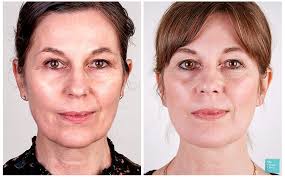
What Is a Liquid Facelift? Understanding the Procedure, Benefits, Risks, and Cost
A traditional facelift is a surgical procedure that lifts and tightens facial tissues to reduce visible signs of aging. However, surgery isn’t the only option for those seeking a youthful appearance.
A liquid facelift offers a noninvasive alternative for individuals who prefer minimal downtime and want to avoid surgery. It uses injectable treatments like fillers and Botox to contour and rejuvenate the face.
According to Dr. David Shafer, a plastic surgeon in New York City, a liquid facelift is best suited for patients with mild skin sagging but noticeable facial volume loss.
He adds that this treatment can provide a refreshed, natural-looking result with less recovery time compared to traditional surgery.
How Does a Liquid Facelift Work?
A liquid facelift involves strategically injecting dermal fillers and sometimes neuromodulators like Botox to lift and reshape facial features.
These injections can restore lost volume, smooth wrinkles, and enhance facial contours.
Dr. Kathleen Suozzi of Yale Medicine explains that the term “liquid facelift” refers to a concept rather than a single technique. Each procedure is customized based on the patient’s needs.
In many cases, doctors use multiple types of injectable fillers and techniques during one session to achieve balanced results. Treatment areas often include the cheeks, jawline, temples, and under the eyes.
Injectables are commonly placed in the mid and upper face to give a lifting effect by pulling tissues upward and backward. Results are visible almost immediately after the procedure.
Key Differences Between Surgical and Liquid Facelifts
The primary difference is that a liquid facelift is nonsurgical. It involves no cutting or stitches, and recovery time is significantly shorter.
However, the effects of a liquid facelift do not last nearly as long as those of a surgical facelift. Surgical results may last over 10 years, while fillers usually last between 6 to 18 months.
Another notable difference is cost. A surgical facelift can cost over $11,000 on average.
In contrast, a liquid facelift typically costs between $2,000 and $4,000, depending on the type and amount of product used.
Because a liquid facelift does not tighten the skin in the same way surgery does, it may not be suitable for people with significant skin laxity or deep wrinkles.
What to Expect During the Procedure
A liquid facelift is performed in a clinic or medical spa and typically takes less than an hour. First, the physician identifies target areas such as the cheeks, jawline, brow, and under-eyes.
The treatment begins with the application of a topical numbing cream to minimize discomfort. The cream stays on for about 20 minutes until the area becomes numb.
Once the numbing cream is removed, the skin is cleansed and prepared for injections. Each injection is placed with precision to achieve a natural lift and improve facial symmetry.
Most patients report minimal discomfort during the procedure. The full session, including numbing and injection time, generally takes 30 to 45 minutes.
Types of Fillers and Injections Used
A variety of injectable products can be used in a liquid facelift. The most commonly used are hyaluronic acid fillers, which restore hydration and plumpness to the skin.
Hyaluronic acid is naturally found in the body and is well-tolerated by most people. Some of these fillers are firm for better lifting, while others are softer and used for subtle refinements.
Another filler is calcium hydroxylapatite, found in Radiesse. This filler mimics bone structure and provides strong support in deeper facial areas like the jawline or nasolabial folds.
However, due to its dense nature, it is not ideal for delicate areas like the lips or under the eyes.
Poly-L-lactic acid, marketed as Sculptra, is another option. It stimulates collagen production over time and is often used in conjunction with other fillers for longer-lasting results.
Unlike other fillers, poly-L-lactic acid requires multiple sessions, but its effects can last up to two years.
Botulinum toxin, such as Botox or Dysport, is sometimes used during a liquid facelift to relax facial muscles. This softens dynamic wrinkles, such as those on the forehead and around the eyes.
Botox adds to the overall smoothing and lifting effect and can be used alone or in combination with fillers for a more complete rejuvenation.
Aftercare and Recovery
After receiving a liquid facelift, you might experience mild redness, swelling, or bruising at the injection sites. These symptoms typically resolve within a few days to two weeks.
Doctors often recommend applying ice packs and avoiding strenuous exercise or excessive sun exposure for a couple of days post-treatment.
Avoid using exfoliating products or undergoing facial treatments like peels for at least a week. Use a gentle cleanser and moisturizer to care for your skin.
Also, you should avoid alcohol, blood thinners, and anti-inflammatory drugs such as aspirin or ibuprofen before and after treatment to minimize bruising.
Results are visible immediately, although some swelling may briefly obscure the final outcome. Full results are typically seen within one to two weeks.
Benefits of a Liquid Facelift
A liquid facelift can enhance facial features in several ways. It lifts sagging areas, restores lost volume, and smooths out lines and wrinkles with minimal discomfort.
It also refines facial contours such as the jawline and cheekbones and can even help with under-eye hollowness and brow drooping.
For many patients, the treatment creates a rested and youthful look without the extended recovery time of surgery.
Another benefit is customizability. The procedure can be tailored to meet each individual’s unique needs and concerns.
The treatment is also reversible. If a patient is unhappy with the results of hyaluronic acid fillers, an enzyme called hyaluronidase can dissolve the product quickly and safely.
Who Is a Good Candidate?
Ideal candidates are those with mild to moderate signs of aging, including volume loss, fine lines, or minor sagging. They should be in good overall health and have realistic expectations.
Younger patients in their 30s or 40s often choose this treatment as a preventative approach to aging. Older individuals with more advanced sagging may not see dramatic results.
People with very loose or heavy skin may not be ideal candidates. Using too much filler to compensate for this can result in an unnatural, overfilled look.
Obese patients or those with very full faces often do better with surgical procedures like facelifts or neck liposuction to define the face and neck.
Also, this procedure is not recommended for pregnant or breastfeeding individuals or those with allergies to filler ingredients.
People with medical conditions such as nerve disorders or neuromuscular diseases should consult their physician before undergoing this treatment.
Risks and Considerations
While generally safe, a liquid facelift is not risk-free. Common side effects include swelling, bruising, or tenderness at injection sites.
More serious risks include infection, allergic reactions, or vascular complications, such as tissue necrosis or even blindness if fillers are injected into a blood vessel.
Because of these risks, it’s important to choose a qualified, board-certified professional with in-depth knowledge of facial anatomy and safe injection techniques.
Never attempt to receive filler injections from untrained individuals or uncertified clinics. Precision and experience are crucial in avoiding complications.
How Much Does It Cost?
The cost of a liquid facelift varies depending on the injector’s experience, geographic location, and number of products used.
Most patients require between two and four syringes of filler, with prices ranging from $600 to $1,500 per syringe. Some clinics may charge a flat fee for the entire procedure.
Overall, you can expect to pay anywhere from $2,500 to $7,500 for a full treatment. Botox and other add-ons may increase the cost.
Where to Get a Liquid Facelift
Only receive a liquid facelift from a licensed medical professional, ideally a board-certified dermatologist or plastic surgeon.
Avoid med spas or technicians without medical training. A skilled injector will understand facial anatomy and how to minimize risks while delivering natural-looking results.
“Proper training and experience are essential,” says Dr. Shafer. “The injector’s skill directly affects both safety and aesthetic outcome.”
If you’re considering this treatment, schedule a consultation to discuss your goals and determine whether a liquid facelift is appropriate for you.
Final Thoughts
A liquid facelift can offer impressive, non-permanent results for those looking to rejuvenate their appearance without surgery.
It’s best for individuals experiencing early signs of aging or looking to enhance their features with little recovery time.
While more affordable and convenient than surgery, the results are temporary and best maintained with ongoing treatments.
Always choose an experienced medical provider, and make sure you fully understand both the benefits and limitations before deciding.


